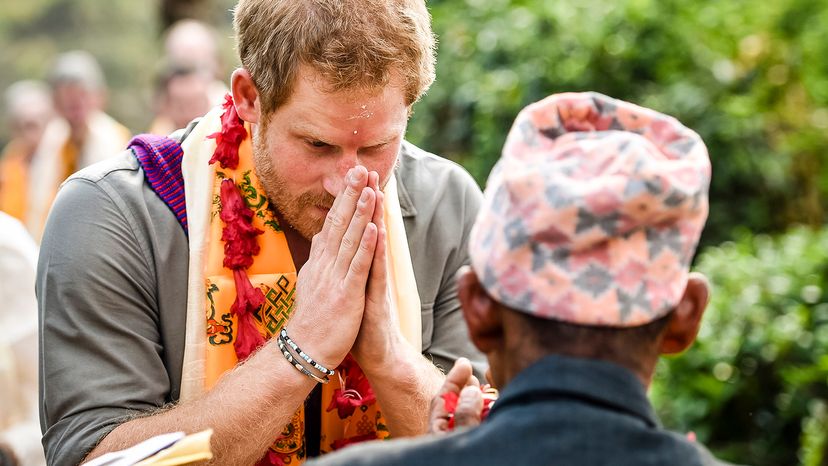 “Prince Harry exchanges a namaste greeting with a villager from Bhir Kuna, Nepal, during a March 2016 visit. Ben Birchall – Pool/Getty Images
“Prince Harry exchanges a namaste greeting with a villager from Bhir Kuna, Nepal, during a March 2016 visit. Ben Birchall – Pool/Getty Images
Long before I dove into my 200-hour yoga teacher training, I became well-acquainted with the term "namaste." Aside from hearing it at the close of most yoga classes, I saw it sprinkled into wellness product marketing campaigns, co-opted on graphic tees and transformed into a pun on way too many holiday cards ("nama-sleigh — get it??").
Although namaste seemed to be everywhere, I realized that when it came time for students to respond to their teacher’s namaste at the end of studio sessions, many yogis garbled the word, or said it under their breath, or didn’t say it at all.
The hesitation to embrace namaste might stem from the fact that the word’s true meaning has often been overlooked or completely erased in the modern Western world. It’s perfectly OK to skip using the term if you feel an uncomfortable sense of appropriation in your usage, but learning the root and meaning might help enrich your understanding of its significance on the mat and beyond.
Namaste is a Sanskrit word that has religious and secular meanings tied to both Hinduism and yoga. Americans usually pronounce the term "NAH-muh-stay," (although those who’ve used the phrase all their lives may pronounce it "num-us-teh"). The term is typically accompanied by a head nod with palms pressed at the heart in prayer (known as anjali mudra). That physical gesture is tied to the term’s root meaning — the Sanskrit meaning is loosely translated to "bowing to you" or "I bow to you." The word itself is a phrase, comprising the terms "namah," meaning "bow, adoration, or obeisance," and the pronoun "te," meaning "to you."
While you might be most familiar with the phrase as a common closing statement in a yoga context, "namaste" (and its variations "namaskar," "namaskaara" and "namaskaram") is actually a greeting that can be interpreted as a way of expressing, "I honor the Spirit in you which is also in me." At its core, the phrase is meant to signify equality and respect. A few other interpretations of its meaning include "my energy salutes the energy lying within you," "I recognize the power of divinity that dwells in your heart," and "I welcome the place where you and I meet."
The Chopra Center sums up the spiritual connection to the connotations of "namaste" with this quote from Christopher Wallis, a scholar of Tantra, a branch of Indian spiritual studies: "Once you become aware of the true nature of reality, everything you do becomes an act of reverence. Simply living your ordinary daily life with full awareness becomes a complete practice of meditation, a perfect form of worship, an offering to all beings and to Being itself."
The modern take on namaste varies, depending on whom you ask. Your odds of hearing it uttered as a sort of spiritual nod in a U.S. yoga studio are decent, but you might not hear it at all amongst yogis in India. But whether you choose to use the term, it’s probably not a bad idea to abide by the principles it’s come to represent to many. As Subhamoy Das, co-author of "Applied Hinduism: Ancient Wisdom for Today’s World," wrote, "when we greet one another with namaste, it means, ‘may our minds meet.’ The bowing down of the head is a gracious form of extending friendship in love, respect and humility."
Now That’s Interesting
The word "yoga" is adapted from the Sanskrit word "yuj," which means "to yoke or bind." In that context, yoga is often interpreted as a practice of "unifying."


